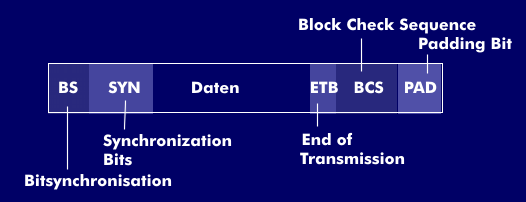binary synchronous communication (BSC)
Binary Synchronous Communication(BSC) is a synchronous, character-oriented IBM connection protocol that handles its services at the link layer. The method is also called BISYNC and uses a defined sequence of control characters for the synchronous transmission of binary coded data between stations of a communication system.
The data is combined in blocks (character- or byte-wise), provided with control characters and check characters and transmitted in half- duplex mode. The entire transmission frame consists of the bit synchronization( BS) followed by the synchronization flag( SYN) and the user data terminated by the End of Transmission( ETB). The following data fieldBlockCheck Sequence( BCS) is used for the block check string and the final PaddingBit( PAD) for padding the data frame.
Operation is performed by requesting a master station to send data to a slave station. The received data ischecked for transmission errors and acknowledged or re-requested by the master station. The bisynchronous method is suitable for point-to-point and for point-to-multipoint connections. The BSC protocol was developed in the 1960s and was the most widely used form of communication on large IBM computers in the 1960s and 1970s.

